- Flying the Eclipse: Flying by Looking at: Glass, Gauges, and Out the Window
| Flying the Eclipse | |
| | Integration: The Big Picture |
| | Flight Directors to Trend Monitors |
Flying the Eclipse
Flying by Looking at: Glass, Gauges, and Out the Window
BY DAN McELROY, ELLI McELROY, and DANIEL McELROY
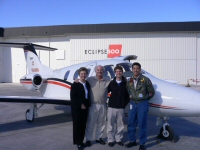 Elli, Daniel, and Dan McElroy with Eclipse demo pilot Kemo Percival. |
Many articles have and will be written about the Eclipse 500's integrated systems, manufacturing, and its affect on aviation. I wanted to write an article about the ease of flying a jet.
As an experienced airline pilot, I have always been surprised that so many people think flying jets is so much harder than flying aircraft with reciprocating engines - "recips." Now that I am retired, I can let the secret out - flying jets is much easier. The average person thinks that because we have reciprocating engines in our cars instead of turbines, they must be easier to operate. This just is not so. In the past, because of technology constraints turbines were more expensive, but we have all seen how technology has helped bring so many things to a mass market; this is now happening with the advent of very light jets (VLJs).
So this is a story of how three pilots feel about their test flights in the Eclipse 500. We have different levels of experience and want to report on how those levels affected our comfort and ease in the cockpit. My family has an early delivery position and has been a strong supporter of the Eclipse from day one.
I am a retired Delta Pilot with about 17,000 hours. I am type-rated in two glass-cockpit airplanes, the MD-88 and B-777, and have a fair amount of experience in a Citation Bravo. My wife, Elli, flew for a commuter airline in Beech 99s and has about 4,000 hours in singles and twins and no glass experience. Our son, Daniel, has about 220 hours. Most of his time is in a Taylorcraft BC-12D. He is working on his instrument rating in a Cessna 182.
Dan's story: Glass
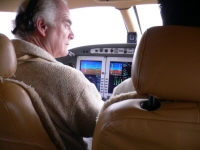 Retired Delta pilot Dan McElroy found the Eclipse offered powerful, user-friendly avionics. |
I soloed in 1968 in a Cessna 150. There were about 11 gauges, eight switches, and four engine controls. The T-37 I flew in the Air Force at Reese Air Force Base in 1973 was a huge jump. I once counted 30-some gauges, 20-some lights, 20-some controls, and more than 100 switches. The T-38 was not much different in complexity, but the layout was better for making the "cross-check" easier.
I went on to fly C-141s during the Vietnam era, and then the venerable B-727 with Western Airlines. I have more than 6,000 hours in the cockpit of the "Tri-Motor," a true jet with all of the bells and whistles in the cockpit. The term "integration" had not yet come to the cockpit. This cockpit was filled with a lot of heavy, well-built systems. It had enough systems to carry a systems specialist;" these were the days of the Flight Engineer-Turbojet.
The next airplane I flew for the airlines was my first glass cockpit, the McDonnell Douglas MD-88. I have about 3,000 hours in the "Mad Dog," as it is affectionately known to Delta pilots. After that I flew internationally across the Atlantic on the Boeing B-777. I had about 1,000 hours flying the "Triple Seven" when I retired. I have about 30 hours and 15 landings in a Cessna Citation Bravo.
My goal for the Eclipse test flight, besides feeling and seeing how the Eclipse 500 handled, was to experience the integration of its systems. (See accompanying stories.)
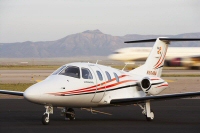
After flying the Eclipse 500, three main attributes stand out in my mind: solid airframe, immediately responsive thrust, and powerful, user-friendly avionics.
Engine start was a simple turn of the knob. With my experience in the B-777, I already understood what was happening. The FADEC takes care of everything: electrical download, switch and valve positioning; temperature, pressure, and acceleration-rate monitoring; starter duty cycles; entrance of fuel into the start sequence; and everything else you might forget or not notice that must be monitored with every start. One of the best things a computer can do is monitor.
Taxiing was sheer joy. The nosewheel steering was smooth and positive with about 60 degrees of travel while rolling. With brake pressure on the inside wheel you could easily spin the airplane in a tight arc. The brakes were proportional with only light pressure required to get positive results. The taxi surface could be felt while moving through both the airframe and rudder pedals, but was dampened out by the solidness of the jet. This was the first time I felt just how solid the airplane feels.
Take-off was smooth. There was a crosswind but very little effort was required to keep the jet accelerating down the centerline. I had heard that the airplane was heavy on the pitch axis on rotate and this was true. (Dr. Oliver Masefield, Eclipse Aviation senior vice president, and his team are working on tweaking this a little more, and if he says he can make something better, I believe him.)
Lift-off was solid. The sense that you get with most airplanes on beginning to develop lift and the straining that you feel with most airframes as you beg them to climb was not there. We had full fuel and four people lifting off at Albuquerque (about 300 pounds under gross) and I only needed to point the airplane where you wanted to go and it responded.
Climb-out gave me time to better understand the controls. We have all been taught how to control an airplane; you envision where you want the airframe in space in terms of bank and pitch. Then you move the controls to get it there. Then you trim the pressures off of the controls and analyze your results.
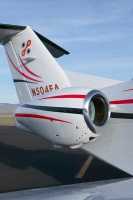
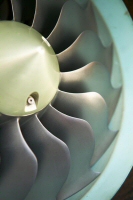
In real life we get sloppy and fly with continuous pressures on the controls or we move the controls with trim. With the side stick it is important to remember the basics. The airplane is small and turbulence can buffet you out of your desired flight path. The 500 is very stable and will right these upsets in time, but the proper way to fly is to use the primary controls and put the airplane back where you want it, then check for pressures and reset them as necessary with trim. The elevator trim is fast and proportionate. The airframe I flew on this test flight did not have the final wing-to-body fillets and required small amounts of aileron trim with speed changes. I never touched the rudder trim.
Area work on my flight test included tight turns, speed changes, climbs and dives, and some single-engine simulations. The airplane was very stable in 45-degree banks, required only a small amount of backpressure, and showed that the airplane provides remarkable visibility. The 60-degree-bank turns required a substantial amount of backpressure, but again I felt how solid this airplane is.
I practiced a single-engine approach, at altitude, then a go-around with partial flap and the gear down. I was able to apply go-around thrust on the one engine and climb, dirty, with my feet flat on the floor and no rudder trim (as a demonstration). The airplane flew slightly skewed with the aileron I had to put in, but was completely controllable. I added the proper amount of rudder and it straightened up.
Climbs and dives were a dream to perform. This is where I learned more about the throttles. In all of the jets I have flown, I was taught to baby the throttle movements. Jet engines are changing temperature and masses being spun at high speeds. The FADEC knows this, and will only allow changes to occur at a proper rate to keep the engine happy and safe. Plus, there is such a small amount of mass in this engine that the thrust changes are almost immediate.
The throttle levers are smooth and only hooked to some electronics so the feel is great. Electronically they are hooked to the engines in an almost perfect linear pattern. If you want half of the thrust you push the levers half of the way up. If you want two-thirds of the thrust you push the levers two-thirds of the way up. The result is almost immediate and the airplane responds accordingly. These are the most linear and smooth power applications I have ever experienced in an airplane.
Pattern work also was easy. I dropped the gear and partial flaps at about 180 knots. The airplane had small pitch changes because of configuration changes and the powerful trim made it easy to keep ahead of the game. Once I found the speed I wanted, I just brought some power back in and it was easy to fly a stable approach. I flew final at about 90 knots. I am sure the aircraft will fly slower without any problem, but being new to the airplane it made it more comfortable and gave me a little extra time in the flare. The trailing-link gear made all six of my landings feel and look good. The airplane gets into noticeable ground effect and it is easy to control the touchdown. After landing, the nose wants to drop, but it is easy to slow that rate with the stick.
My single-engine landing was a simple task. I landed with partial flaps and approached at 100 knots. The airplane always had a completely solid feel here also. I never felt behind the power curve, because the power is so ample with the one engine and its response is so fast. I never bothered to put in rudder trim since the pressure with the pedals was so light and I had such a confident feeling of positive control at all times.
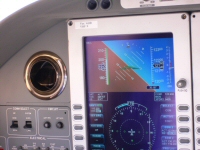 The panel offers a logical layout with three flat-panel screens. |
The panels and displays are well laid out. I turned many times and the sun came from every conceivable angle, yet there was never washout or glare in the cockpit. The readouts were easy to see and the pictorial diagrams of all of the pages were logical and easy to interpret. This was an early version of the software and not all pages were available but easy logic permeated all that I saw.
Any new software you use on a computer today takes time to get comfortable with. This will be no different. Likewise, once you learn a software package, it becomes second nature. The avionics and system controls in this airplane are all software driven and you will have to take the time to get to that comfort level before you venture out.
Kemo Percival was our demo pilot. Percival has been with the team since the summer of 2005, but has already flown the Eclipse more than 250 hours (our test flight was in January 2006). Percival also is in the Navy Reserves and flies the F-5 as an aggressor pilot, keeping our Naval Flight Officers on their toes. His demeanor in the cockpit was soothing and helped build confidence. He also is generous with the airplane; he let us do all the flying and he did all of the "work" so that it was a truly pleasurable experience.
My thanks also go to Brigid Wainwright and Perry Denker for helping us arrange these test flights. The big thank you has to go to Vern Raburn, who has put together a group of talented and motivated artisans. We all need to thank him for his dedication and perseverance to bring aviation to the next generation. This will be an era of new turbine-powered airplanes. This will also be an era of a whole new transportation system that will give us more time, flexibility, and convenience.
Elli's story: Gauges
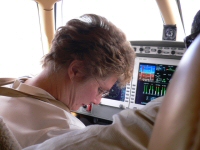 Elli McElroy found the side stick to be a challenge. |
I soloed in 1968, in a Cessna 150, at the same airport and FBO as my husband Dan. We did not meet for six years. It turned out that he was my instructor for a class I was taking to prepare for the Flight Engineer-Turbojet written tests.
Our first date, a lunch date, was doing aerobatics in a Citabria. He proposed to me at 9,000 feet over Oshkosh, Wisconsin, and still claims he must have been "hypoxic." I must be hypoxic to stay with him and his aviation sickness after 30 years, but aviation has always been a good part of our family.
I was the first female pilot hired by Cascade Airways. Another gal was hired for my class and she is still flying for Northwest Airlines. I flew the Beech 99 turboprop. These were fun days of jumping around the state of Washington. I eventually retired my "professional" wings but we have always had an airplane and I stay current and get my share of the "legs." I have never flown glass and was concerned about the transition to the Eclipse 500.
I have been flying since 1968 mostly in C-172s, Bonanzas, Cessna 320s, Cessna 414s, and Beech 99s. I have flown more than 50 different aircraft and have a type rating in the Cessna Citation (1978) (TT 3800+, ATP SEL, MEL, commercial privileges ASES). I came to this flight evaluation from a different perspective than my husband's. Aviation had been the core of my life in the 1970s and 1980s. Since the 1990s, aviation has been a part of my life, but not the center of it. I transitioned from flight instructor and regional airline pilot to a fair-weather pilot. I still file IFR, but have raised my personal minimums, unless my husband is flying with me.
During my first take-off (my husband flying, our son and I were passengers) my immediate response was that the Eclipse 500 felt and flew like a jet. I am not trying to be funny or sarcastic when I say that. It had the feeling of a big airplane with the quick response of a smaller aircraft. There was a sense of solidness - structural integrity and power-plant reliability.
Another early impression was the aircraft's response to control inputs. They were similar in performance and flight characteristics of the L39 (I have flown in one). I now understood why Eclipse wants upset training in the L39 and why it will be appropriate. I used to teach people how to fly little airplanes. More recently, I read an article on upset training (at my husband's request); it said everything I was already aware of. However, the flight made me feel that all my knowledge of upset training was only a good base for what I would need to demonstrate proficiency in, in order to fly the Eclipse 500. (More about training later.) I was the third of the three of us to fly N506EA.
The aircraft handled well on the ground and taxied easily. The toe brakes were responsive proportionally to my input and differential braking facilitated tighter turns.
The engines: It has been about 28 years since I flew a pure turbine aircraft. The Pratt & Whitney Canada PW610 (P&WC) engines on the Eclipse 500 were incredible. They were more responsive than what I had remembered from years past. One tries to never make rapid power changes in a reciprocating engine for engine temperature control (and resulting structural integrity) and to allow the fuel-air mixture to transition to changes in power demands. The P&WC engine does not need this babying. The electronics do that for you.
The spool-up delay on these engines was almost unnoticeable. I did not have the one- to three-second (or greater) delay I had experienced in other aircraft. The power is there when you need it. This makes transitioning from recips to this pure jet easier for people like me and the average general aviation pilot. Another difference noted from my past experience was how far to advance the throttles. The electronics do not let you over-boost the engines. Therefore, on take-off you advance the throttles all the way forward (you still check your gauges to confirm the system is working properly), but you do not have to fine-tune your take-off power setting. This reduces cockpit workload.
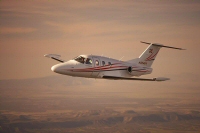
Aloft: The aircraft flew beautifully. It climbed quickly, which is great for getting on top of weather. My flight was predominantly at 250 knots or less. The aircraft we test flew, N506EA, was stable and responsive to flight-control inputs at all speeds. On approach and landing, the aircraft was great; there were no major pitch changes with the extension of gear and/or flaps. The airplane did not have speed brakes available at the time, but they were not necessary in the approach and landing phase. I approached my landings a little hot, yet even with the high-density altitude, the airplane still wanted to fly. It did not give me that sense of dropping out of the sky or running out of lift the minute I reduced power. Because of the airplane's stability, gear design, and low wing (and therefore ground effect cushion), approaches and landings were comfortable, kind, and solid.
The one area that was a challenge for me was using the side stick. (Most of the aircraft I have flown have had control wheels.) I think this was a challenge for me for three reasons. First, it took more force to move the stick to maneuver the airplane about the pitch and roll axes than I had anticipated. Second, I think I was trying to add forces to the stick that were not necessary and therefore I wasted energy. I felt the proper use could easily be learned with practice. Lastly, I do not have much arm strength and my left arm was tired at the end of my flight.
The pickle switch on the stick responded instantly and adjusted the trim quickly to input for both pitch and roll.
At altitude, I did pull back the power on one engine to feel the amount of rudder pressure needed to maintain directional control (without banking into the good engine). It required a heavy foot, but was not dramatically different from other twins I had flown. However, I was glad rudder trim was readily available if I wanted it.
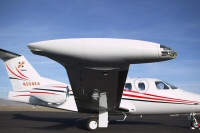
Cockpit: The cockpit has a logical layout with three flat-panel screens. There is a primary flight display directly in front of each pilot with a center multifunction display containing the engine and systems information. A third electronic attitude instrument was on the center panel. Visibility from the pilot seat was excellent.
The altitude and heading displays were easy to read. I was not used to the linear-vertical format flight instruments for airspeed and altitude. These instruments also had boxes integrated with the same information displayed in digits. As with anything new, practice will help me become more comfortable at interpreting these gauges. (I am used to the old dial format.)
I know nothing about glass cockpits, but it looks as if the engineers have put a lot of thought into the system design and ease of use with combinations of pages, line items, and schematics. I look forward to ground school when I can see how it is all pulled together.
Cabin: The cabin environment was kept comfortable with controls and good airflow to the cockpit and passenger cabin.
Impressions: I came away from this flight with several primary impressions. The Eclipse 500 truly is the next generation of aircraft. It is a pleasure to fly and it will meet the aviation needs of a wide range of pilots and users. These might range from the pilot flying his family on vacation or to get a $100 hamburger, to the businessperson customizing and maximizing his travel, to the world of air taxi and regional airlines.
The general aviation pilot can make this transition. The steps outlined for transition from recips or low flight time to the Eclipse 500 are realistic. They include upset training in the L39, altitude chamber training (to learn your personal reaction to hypoxia so you can recognize it and take appropriate action), ground school and flight training, and mentor pilot as needed. It is a system in place for a safe, exciting, and fulfilling transition. If you have ever wanted to join the jet set for whatever reason - this is it!
Daniel's story: Out the window
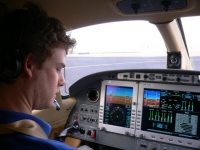 Daniel McElroy takes his turn behind the glass in the Eclipse 500. |
I soloed in 2002 in a Cessna 150. If flying was good enough for mom and dad, it was good enough for me. I soloed a week after my sixteenth birthday. I had been making landings in the family Cessna 414 since I could just see over the glareshield on dad's lap.
With less than an hour on my new private certificate, dad and I flew our Taylorcraft BC-12D to Albuquerque and back for spring break in 2004. Dad did not have a medical at the time, so I was pilot in command for the 10-day, 32 and a half hour trip. We did this with a communication radio but no electronic navigation. We used a whiskey compass and sectional maps. One day we flew more than six hours following Interstate 40 and continuously watched the car and truck traffic pass us. Dad finally let me get a GPS when we got back. I think he decided that he does not like to be lost either. After watching my dad turn on the engines, (literally; he turned the two engine switches 90 degrees and let the FADEC go to work), I sat in the middle row and noticed just how roomy the airplane felt even for a cabin that looked small from the outside. The seats were comfortable and the seatbelts were a mix of car seatbelts over the shoulder and typical airplane seatbelts around the waist. Once Kemo Percival gave my dad the go ahead, dad advanced the throttles ever so slightly and the little jet started rolling slowly.
My dad made the first take-off and touch and-go, and then set it down for the final landing. After taxiing to a stop, he and I switched positions and I climbed into the pilot seat and put on the seatbelt while Percival held the brakes. Once I was cleared for takeoff, I took the runway and decided to be a little more aggressive than my dad. While holding the brakes, I slammed the throttles to the firewall and heard the Pratt & Whitneys go to work. As the engines went through 60-percent power, seconds later, I lifted my feet off the brakes, and was flung into my seat by the force of the airplane's acceleration.
Giving little to no input on the rudders in the 20-knot crosswind, I rotated at 90, raised the gear and flaps, and we were at 150 knots before we crossed the end of the runway. After turning south to go to the practice area, I was instructed to stay under 15,000feet. Even in the climb, I had to keep pulling the power back to keep under the 250-knot speed limit the tower issued us.
After leveling out, I trimmed the airplane to fly straight and level (even with moderate turbulence) and decided to see how it handled. I made hard 60-degree banks at 230 knots only to find that the Eclipse 500 handled remarkably like an L-39. It has a very solid roll, and there is a definite feeling that you are in control. After slowing it up to 120 knots and feeling the characteristics of slow flight, I gave Percival the high sign and we headed back for the airport.
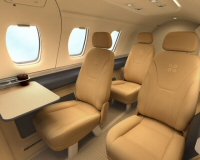
On downwind, I extended the gear and flaps and the airplane slowed very quickly. I lined up about a quarter mile out and gave it the amount of power that I thought would be necessary for a piston airplane to gain two or three knots of speed. About one and a half seconds later, I looked at the airspeed and realized the engines had already wound up so much by the incremental throttle movement, that I had gained 15 knots of speed. I quickly pulled the throttles to idle, and never touched them the rest of the way down. At landing, the jet flared beautifully at the exact spot I wanted it to, while the trailing link landing gear made the landing smooth and almost unnoticeable.
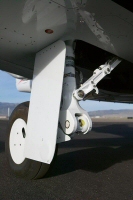
After advancing the throttles one more time, I rotated at 90 knots, and started climbing at about 15 degrees. I saw my airspeed at 130 knots as we passed 5,000 feet per minute in the climb. I started leveling off for the pattern and noticed that at that climb rate I was only losing about one knot per second. I turned downwind then final and made a very tight pattern so I could feel what it is was like to try to slow the Eclipse 500 down. After throwing out the gear and the flaps, the jet quickly and gracefully dissipated the extra energy, which made the rapid descent very easy to accomplish. Once I touched down on the ground, it was hard to wipe the smile off of my face.
While on the ground, I had a better chance to look at the displays. The Avio instruments were easy to see with beautiful colors that lit up the screens. The primary readouts were quick with no delays, and the systems readouts were very easy to recognize and understand. I was impressed with the systems readouts. The pictorial presentation is very intuitive.
Being a 200-hour pilot with only VFR experience, I was slightly intimidated at first when I got into the seat, but the jet was a very easy transition from the 182. Although the Eclipse 500 is much more advanced than the 182, I can already see how the systems on the jet will become easier to operate than the traditional gauges on the 182. Even though this is my mom and dad's airplane, I am going to be very happy to take it off of their hands every now and then.
Posted Thursday, April 27, 2006 11:08:50 AM


